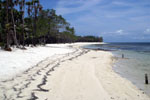
Nesting Beach Monitoring Network
2007 Research Update
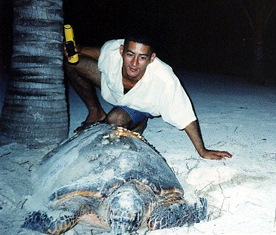
As part of the NBMN, we were excited to have confirmation of hawksbills nesting on the island of Roatan in August, 2007. The hawksbill we confirmed on Roatan gave us hope that there may be other hawksbills nesting in the area, as well as on the other Bay Islands. Our nesting beach work for hawksbills on Roatan is currently being supported by US Fish and Wildlife. We plan to begin a reconnaissance for nesting hawksbills in Utila, Guanaja, and Cayos Cochinos in the coming seasons.
Nesting Hawksbills on Roatan Island
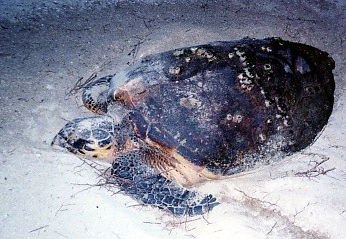
Pictured here is a lovely hawksbill that came up on shore three times over a period of approximately two and a half weeks. She laid nests on her first and third crawls, but did not dig a nest, or leave a clutch on her second crawl. We are making plans to tag this turtle in the summer of 2008 and hope to eventually begin tracking her by satellite in the future.
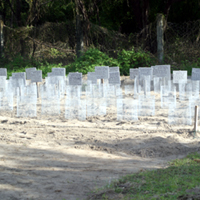
Another project under the NBMN is the Olive Ridley nesting program along the Golf of Fonseca on the Pacific coast. Here, turtles lay eggs over a three month period. During that time, some of the eggs are collected, counted and deposited in a hatchery close to the beach.
Olive Ridley Hatchery
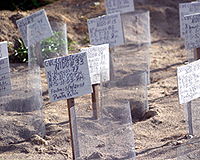
In these photos, you can see that each nest is marked with information about the date and time the nest was laid, the hatchery nest number and how many eggs were deposited in the nest.
Olive Ridley Hatchery nest markers
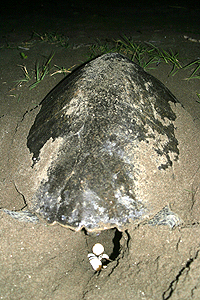
Our plans in the near future are to study the success rates of hatchery nests in comparison to natural nests. We plan to track nest conditions and collect data on the numbers of eggs that hatch and that survive until the time of release.
Nesting Olive Ridley on the Pacific Coast
Unfortunately, the beaches along the Golf of Fonseca have 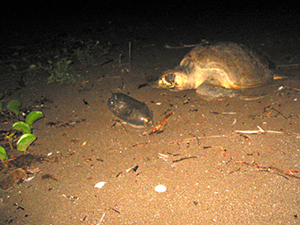 a common feature of many beaches around the world – litter! Litter, such as the plastic bottles and bags you can see in this photo, may act to interfere with nesting turtles, as well as the ability of hatchlings to reach the water before they are detected by predators. Beach rubbish also can lead to the deaths of sea turtles and other marine animals when they ingest bits of plastic and other debris, and this material becomes lodged in their digestive systems. ProTECTOR is working with local communities to develop beach clean-up and monitoring programs throughout the year.
a common feature of many beaches around the world – litter! Litter, such as the plastic bottles and bags you can see in this photo, may act to interfere with nesting turtles, as well as the ability of hatchlings to reach the water before they are detected by predators. Beach rubbish also can lead to the deaths of sea turtles and other marine animals when they ingest bits of plastic and other debris, and this material becomes lodged in their digestive systems. ProTECTOR is working with local communities to develop beach clean-up and monitoring programs throughout the year.
Litter near a nesting Olive Ridley
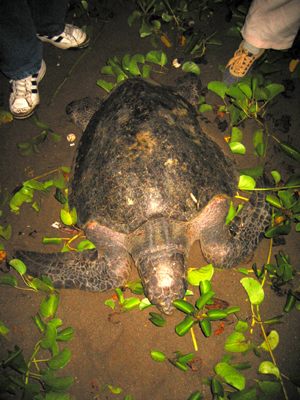
As part of the Olive Ridley program along the south coast, we are, for the first time, beginning to take measurements of nesting females and the eggs they lay.
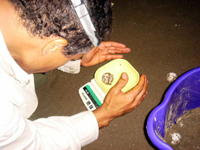
Here, Steve Dunbar weighs each of 10 eggs to get a range of egg weights and sizes.
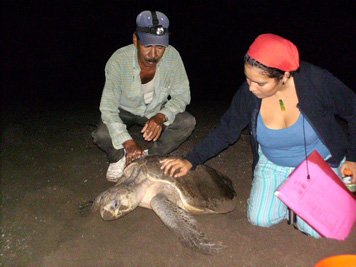
In this photo, Lidia Salinas works with a local community program leader to collect Morphometric data on the female turtles that come to lay eggs each night. One of the measurements recorded is the Curved Carapace Length (CCL). We also record the Curved Carapace Width (CCW), Straight Carapace Length and Width (SCL, SCW). We are also taking small skin samples that will later be used for genetic analyses and applying metal flipper tags to each female for identification each night and from year to year.
Lidia Salinas collecting data
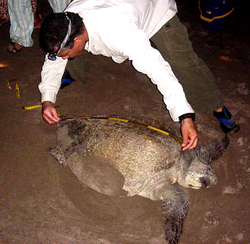
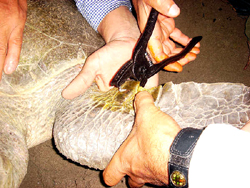
Steve Dunbar collected nesting turtle data
| Data Collectors |
| Bottles 2 Buildings |
| ResearchGate |
| ProTECTOR Inc. Youtube |
| Interns and Volunteers |
| ProTECTOR Store |
